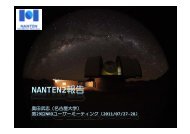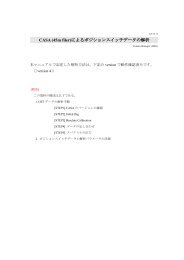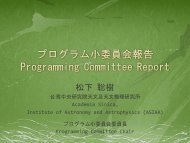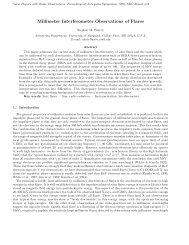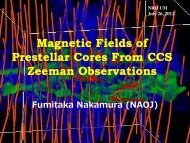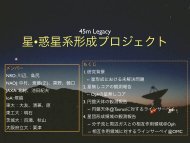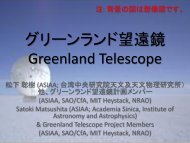Physics of the Solar Active Regions from Radio Observations
Physics of the Solar Active Regions from Radio Observations
Physics of the Solar Active Regions from Radio Observations
Create successful ePaper yourself
Turn your PDF publications into a flip-book with our unique Google optimized e-Paper software.
48 G. GelfreikhFig. 8.. The gyroresonance emission layers responsible radio emission <strong>of</strong> sunspot- associated sources and expected effect <strong>of</strong> MHD-waveson <strong>the</strong> emission (top). The structure <strong>of</strong> <strong>the</strong> radio source <strong>of</strong> an active region (August 16, 1992) — <strong>the</strong> RATAN-600 observations (lowerleft). The spectra <strong>of</strong> polarized component <strong>of</strong> <strong>the</strong> source for 5 days (lower right).a new important method for detailed study <strong>of</strong> <strong>the</strong> structure <strong>of</strong> coronal magnetic fields for weak active regions, withno sunspot inside.4.4. Faraday RotationThe angle <strong>of</strong> Faraday rotation is determined by <strong>the</strong> formula:∫θ = const · λ 2 · B l · N e dl (3)The effect is very sensitive to <strong>the</strong> magnetic field strength and wavelength and needs observations with narrowwavebands. The integral in this equation is called rotation measure. The observations at a number <strong>of</strong> frequenciesmay result in its determination. As far as <strong>the</strong> radio observations <strong>of</strong> <strong>the</strong> sun are concerned <strong>the</strong> main problem isdue to <strong>the</strong> effect <strong>of</strong> limiting polarization when a radio wave leaves <strong>the</strong> sun. The presence <strong>of</strong> linear component is anexception in solar observations. It may be <strong>the</strong> case <strong>of</strong> mode coupling in <strong>the</strong> QT region in <strong>the</strong> corona above an AR.Such a case was investigated by Alissandrakis using observations with WSRT (Alissandrakis et al. 1994).The o<strong>the</strong>r way is to use observations <strong>of</strong> linearly polarized sources, like Crab Nebula (Parijskij et al. 1980, Sobolevaet al. 1983). Such observations provide some interesting information about magnetic field in <strong>the</strong> outer corona.5. OscillationsThe microwave observations are important not only in <strong>the</strong> study <strong>of</strong> plasma parameters but also dynamical processesessential for <strong>the</strong> problems <strong>of</strong> generation, transfer and release <strong>of</strong> energy in magnetospheres <strong>of</strong> <strong>the</strong> solar ARs. Animportant agent in transfer <strong>of</strong> non<strong>the</strong>rmal energy <strong>from</strong> below <strong>the</strong> photosphere is flux <strong>of</strong> MHD waves. The study <strong>of</strong><strong>the</strong>se waves also provides an important tool in diagnostics <strong>of</strong> sub-photospheric structure <strong>of</strong> <strong>the</strong> sun (helioseismology).In plasma-magnetic structures <strong>of</strong> <strong>the</strong> solar atmosphere we expect to get resonance cavities <strong>of</strong> some modes <strong>of</strong> <strong>the</strong>sewaves. We do expect <strong>the</strong>ir manifestation in different components <strong>of</strong> <strong>the</strong> radio emission <strong>of</strong> an AR. In fact, manyperiods, <strong>from</strong> several minutes to half an hour, were found by a number <strong>of</strong> researchers.



